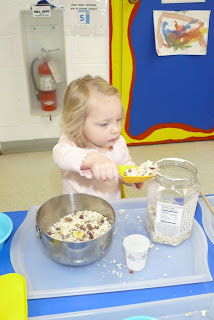The teacher of our twos program, Lini, had such a hit with her center activity last week, that I asked her to share it with us in another guest post from her.
It is difficult to find a good baking activity to do with 2 yr olds that does not require an adult hovering closely to make sure there is not a tablespoon of salt in the cookies rather than a teaspoon.
I was so pleased to discover the perfect recipe for 2 yr olds - granola!
The children scooped and mixed the oats, seeds, fruits and coconut pouring from one bowl to another and stirring with a wooden spoon. There was no hovering!
Eventually all the oats & mix-ins landed in a large jar (like a Costco sized pretzel jar) we whisked the melted butter and honey together and poured it over the oats, shaking it in the jar to combine.
We enjoyed it at snack time and each child took a small bag home with them, I got several requests for the recipe, it was DELICIOUS!
So here it is:
GRANOLA RECIPE
6 C Old Fashioned Oats
approx 1/2 C each raw sunflower seeds, raw pumpkin seeds, golden raisins, craisins, banana chips, unsweetened coconut
Melt one stick butter, mix in 1/4 C honey & 1/2 C canola oil and pour over oat mixture, mix well. Spread on baking sheet, bake at 325 degrees for 20-30 min stirring every 10 min.

















































